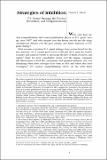Strategies of Inhibition: U.S. Grand Strategy, the Nuclear Revolution, and Nonproliferation
Author(s)
Gavin, Francis J.
DownloadGavin-Strategies of Exhibition.pdf (169.9Kb)
PUBLISHER_POLICY
Publisher Policy
Article is made available in accordance with the publisher's policy and may be subject to US copyright law. Please refer to the publisher's site for terms of use.
Terms of use
Metadata
Show full item recordAbstract
The United States has gone to extraordinary lengths since the beginning of the nuclear age to inhibit—that is, to slow, halt, and reverse—the spread of nuclear weapons and, when unsuccessful, to mitigate the consequences. To accomplish this end, the United States has developed and implemented a wide range of tools, applied in a variety of combinations. These “strategies of inhibition” employ different policies rarely seen as connected to one another, from treaties and norms to alliances and security guarantees, to sanctions and preventive military action. The United States has applied these measures to friend and foe alike, often regardless of political orientation, economic system, or alliance status, to secure protection from nuclear attack and maintain freedom of action. Collectively, these linked strategies of inhibition have been an independent and driving feature of U.S. national security policy for more than seven decades, to an extent rarely documented or fully understood. The strategies of inhibition make sense of puzzles that neither containment nor openness strategies can explain, while providing critical insights into post–World War II history, theory, the causes of nuclear proliferation, and debates over the past, present, and future trajectory of U.S. grand strategy.
Date issued
2015-08Department
Massachusetts Institute of Technology. Department of Political ScienceJournal
International Security
Publisher
MIT Press
Citation
Gavin, Francis J. “Strategies of Inhibition: U.S. Grand Strategy, the Nuclear Revolution, and Nonproliferation.” International Security 40, no. 1 (July 2015): 9–46. © 2015 by the President and Fellows of Harvard College and the Massachusetts Institute of Technology
Version: Final published version
ISSN
0162-2889
1531-4804